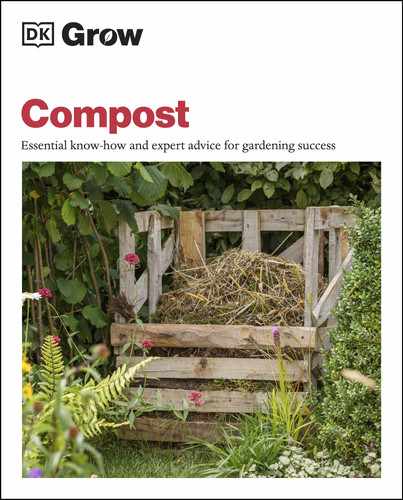MAINTAINING A LUSH LAWN
Green lawns can be difficult to maintain in summer without watering and the use of artificial fertilizers, but composting the clippings can provide a more eco-friendly maintenance solution. Grass releases plant nutrients and moisture as it decomposes, which means that when the clippings are left to rot down on the soil between the leaves, they soon help to produce a healthy, lush lawn.

Grass clippings can boost the drought-tolerance of a lawn.
SELF-COMPOSTING CLIPPINGS
The easiest way to ensure that a lawn has the nutrients and moisture needed for healthy growth is to mow it and leave the clippings where they lie. Grass clippings will replenish your lawn with at least 25 percent of the nutrients it requires, thereby reducing the need for artificial fertilizers. This helps to lower your carbon footprint and reduce the use of fertilizers, which can damage the environment by leaching into ground water and then polluting rivers and oceans.
The aim of this composting method is to leave the mowings to settle on the soil between the grass blades, where they will form a protective layer, helping to reduce weed growth and conserve moisture by reducing evaporation rates. As they decompose, they will also be taken down into the soil by worms, where they will release their nutrients and feed the grass roots.
To prevent your lawn from being engulfed by a soggy mass of clippings, which will damage the grass, make sure that your mower blades are sharp and on their highest setting. Remove just one-third of the length of the grass, or about 1in (2.5cm), each time you mow. This may mean cutting the lawn more than once a week in spring and summer, but since you do not have to pick up the clippings, it should be quite an easy task. To support the taller grass leaves, the plants develop longer roots that reach down into the lower depths of soil where moisture collects, thereby providing even more protection against periods of drought.
If you find your lawn looking a little lackluster, check that the depth of decomposing grass clippings, known as thatch, has not exceeded about 1⁄2in (1cm). This may be inhibiting the free flow of air into the soil and preventing the new clippings on top from coming into contact with the decomposing microbes in the soil. To rectify this problem, rake up some of the thatch and add it in thin layers to a compost bin or use as a mulch on your beds (see Growing Beans in a Compost Trench), as long as you have not recently treated the lawn with herbicides such as a weed and feed product.

Mow the grass with the blades on the highest setting and let the clippings settle on the soil between the leaves.
TOP TIP DO NOT MOW LAWNS AFTER RAIN BECAUSE THE WET CUTTINGS MAY NOT BE EASY TO DISTRIBUTE EVENLY. THEY CAN FORM A DENSE MAT THAT SMOTHERS THE GRASS AND PREVENTS THE SOIL FROM ABSORBING AIR AND WATER.
FEEDING THE LAWN WITH COMPOST
If you prefer a more manicured lawn with shorter grass than is required for self-composting the clippings, you can maintain it using homemade compost instead. Not only will the compost help to improve the soil structure, which in turn will alleviate waterlogging and reduce moss growth, it will also deliver essential nutrients to encourage healthy growth. Top dressings of compost are traditionally applied in the autumn, when they encourage good root growth and improve drainage. However, new studies show that lighter, more frequent applications may work too, starting in spring as the grass begins to grow again. To apply homemade compost, cut the lawn to about 1in (2.5cm) in height to expose the soil between the grass blades, then rake it to remove dead leaves and debris. Sieve well-rotted compost into a bucket, scatter it over the lawn to create a thin layer of about 1⁄2in (1cm), and use a broom to distribute it evenly. Repeat this process every month or two until early autumn when grass growth begins to slow down.

Use a broom to work the compost into the soil between the blades of grass.
Using Compost | MAINTAINING A LUSH LAWN
LEAVING LAWNS TO FLOWER
To increase biodiversity and encourage pollinators into your garden, transform your lawn into a wildflower meadow. Simply leave the grasses and flowers in the lawn to grow taller and bloom; you can also add wildflower plug plants or sow seeds on the surface of the soil in spring. Mow your meadow annually in late summer after the grasses and flowers have set seed, leaving the clippings in situ for a few days to allow the seeds to settle on the ground. Your lawn mower may not be able to cope with long grass, in which case use a rotary mower or an old-fashioned scythe. If the grasses are dominating the flowers, try mowing the meadow twice more throughout the autumn and remove the clippings. After the main summer cut, collect the hay to use as a mulch or add it to your compost heap. These older stems have a high carbon content and are counted as browns, unlike the lush green nitrogen-rich growth of a lawn. They can therefore be added to a heap to balance grass clippings and prevent the compost from becoming too wet.

Making a meadow eliminates the problems associated with composting fresh green grass clippings.
